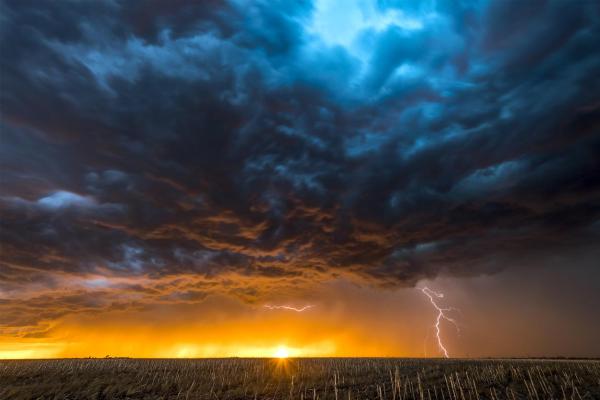What Are Some Examples of Meteorology?


Meteorology is the study of weather, usually for the purposes of forecasting. However, it encompasses a large group of scientific disciplines and is often used in a more general sense of weather studies. For this reason, using the term ‘meteorological’ often refers specifically to something related to the weather. When we look for examples of meteorology, we look at the phenomena studied. At oneHOWTO, we ask what are some examples of meteorology? We look at the most common meteorological phenomena, as well as find out which are some of the most devastating.
What are meteorological phenomena?
A meteorological phenomenon is any observable event or circumstance that occurs naturally in the Earth's atmosphere. Specifically it occurs in the troposphere, the layer of the atmosphere closest to the Earth's surface.
These atmospheric phenomena are due to various factors that affect the troposphere. Among them, the air circulation itself stands out. Air constantly moves in the form of currents and air masses at different temperatures. Solar radiation, atmospheric pressure, geographical factors (latitude), marine currents, relief of the terrain or vegetation of a certain area are all important weather factors. All these factors interact and produce changes that are translated into different meteorological phenomena.
Knowing how meteorological phenomena occur is important not only to better understand the hidden rules of nature that surrounds us, but also to realize the importance of caring for the environment. Climate change may be behind the increase of some extreme weather events.
Examples of the most common meteorological phenomena
There are different types of meteorological phenomena which we can distinguish by taking into account their characteristics (e.g. optical, hydric and atmospheric). Their intensity and impact on nature and human activity are also important considerations. In a very basic classification, there are meteorological phenomena considered normal. These occur regularly and do not usually cause damage. Adverse or extreme phenomena are unusual and can cause material damage and even endanger human life.
The presence of clouds in the sky (cloudiness) is probably one of the most common meteorological phenomena. The terrestrial irradiation itself causes the air to heat up and the water in rivers and seas to evaporate little by little. This water vapor rises until it reaches the coldest layers of the troposphere, where it condenses into tiny droplets that create clouds.
Clouds move freely and give rise to other common meteorological phenomena such as:
- Rain: a type of precipitation which occurs when the drops formed by the condensation of water vapor become larger and end up falling on the earth.
- Snow: it is the same as rain, but it solidifies in its fall when temperatures are below zero degrees.
- Fog: the combination of temperature and atmospheric pressure. The insufficient weight of the tiny drops of water mean that they do not finish falling and remain floating in the layers closest to the Earth.
- Wind: it is a common meteorological phenomenon that is produced due to differences in temperature and pressure between different air masses. Hot air ‘weighs’ less and tends to rise, while cold air tends to fall. This circumstance generates a constant movement that gives rise to more or less intense wind.
- Storm: in principle, a storm does not have to be an adverse phenomenon, unless it becomes high intensity. Its origin starts from a specific type of cloud, the cumulonimbus. In certain circumstances of sudden changes in pressure and temperature, these clouds discharge all the rain concentrated in them, also producing other phenomena, such as thunder and lightning.

Examples of extreme weather events
Extreme weather events are examples or meteorological phenomena which, fortunately, occur less frequently. Temperatures, rainfall or the force of the wind generate situations that imply a certain degree of danger for people and their environment. Some meteorological phenomena have become more prominent in recent years due to climate change and they include:
- Hurricanes, typhoons and tornadoes : a hurricane is a cyclone with a powerful wind exceeding 120 km/hour and moving in a spiral. The lower the atmospheric pressure in the eye of the hurricane, the greater its destructive power. If they have their origin in the oceans (generally in the Pacific), they are known as typhoons. The tornado is a column of air that rotates at high speed (it can exceed 400 km/h) and its end is in contact with the earth.
- Heat waves or cold wave: unfortunately they are increasingly frequent and are characterized by the presence of extreme temperatures, whether high or low. It is considered a wave when the period of abnormal temperatures lasts for 7 days or more.
- Blizzard: this is a severe snowstorm which is accompanied by high winds of a minimum 56 km/h (35 mph). It should last for a prolonged period of time, usually 3 hours or more. It can happen when snow is not falling as precipitation, but it picked off the ground by high winds (ground blizzard).
- Flood: this is usually the result of other meteorological phenomena such as a hurricane. It occurs when water flows in areas which should otherwise be dry, but have a saturation of water usually due to high rainfall.
If you want to read similar articles to What Are Some Examples of Meteorology?, we recommend you visit our Learning category.





